Once again about V.P. Glushko
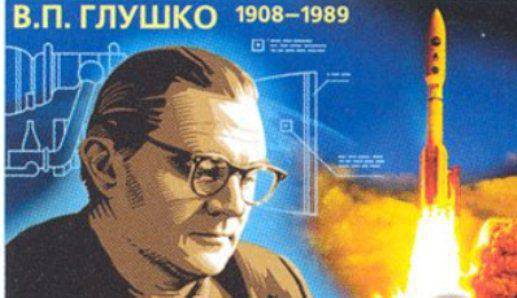
In the distant winter of 1922, in a small hall of the Odessa Public Library, it was impossible not to notice a modest teenager in his overcoat and boots. The library was not heated that winter, and the guy kept chills every now and then.
With his stiff fingers, as if spellbound, he flipped through the yellowed pages and copied whole sheets of a magic book into a notebook. This book - "The study of world spaces with jet instruments" - wrote Konstantin Eduardovich Tsiolkovsky. This teenager was Valentin Petrovich Glushko - the future designer of rocket engines, academician, laureate of the Lenin and State Prizes, twice Hero of Socialist Labor.
He was born in 1908 in Odessa. At thirteen, read Vern's work "From a Cannon to the Moon" and "Around the Moon". These books shook the boy. Glushko recalled that it was after reading these novels that he realized that he had to devote his life to the realization of these wonderful flights. Of course, to achieve their goals requires extensive knowledge. And here without higher education is necessary. But while it is impossible to lose time, and he enthusiastically engaged in descriptive astronomy, goes to the Odessa Astronomical Observatory.
"Observing astronomy fell in love with me," Valentin Petrovich wrote in his memoirs, how he looked with awe at cosmic luminaries with awe. He was fascinated by the proximity of multi-colored planets. The Moon, which seemed close enough to the earth, especially attracted him. The boy was lucky. At the observatory he met with VA Maltsev, who was completing a course at the university and was also in love with astronomy, like Glushko. He shared his dream of space travel with him.
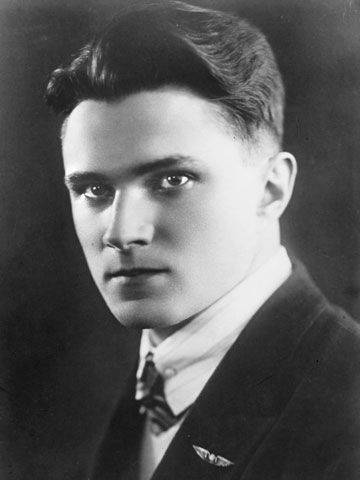
Maltsev seriously took the hobby of his younger comrade. Told him about K.E. Tsiolkovsky, his ideas of interplanetary flights, advised to read the books of the scientist. It was then that Glushko came to the frozen library. To his disappointment, there was only one book of Konstantin Eduardovich.
And how I wanted to read more of the works of the great scientist. And then the thought came to him: “But would you write a letter to Tsiolkovsky? Maybe send a book or two? ". In 1923, Glushko wrote to Tsiolkovsky in Kaluga. With impatience, he awaited a response. And suddenly - a letter, and a parcel with books Tsiolkovsky. The correspondence of the founder of theoretical cosmonautics, an outstanding Russian scientist with a worldwide reputation, and fifteen-year-old Glushko, the future founder of the Soviet rocket engine-building, began. It lasted for several years.
In a letter from 10 in March 1924, Glushko wrote to Konstantin Eduardovich that "interplanetary flights" are the goal of his life, which he dreams of dedicating to this great cause. After reading the sci-fi novel "Out of the Earth" by Tsiolkovsky, the sixteen-year-old Glushko walked for a long time under her impression. He wrote about this to the scientist, stressing that in the artistic story Tsiolkovsky he resolves all the difficulties through physics and mechanics, having foreseen all the difficulties of interplanetary flight, as if the author himself had already done them. "In general," Outside the Earth "- it is even difficult to call a story."
At the age of sixteen, the inspired young man publishes the first article in the newspaper "Izvestia of the Odessa Gubkom VKP (b) U", "The Conquest of the Moon by the Earth 4 on July 1924." The article was a response to press reports about the alleged flight to the 4 satellite of the earth on July 1924 of the automatic vehicle of R. Goddard. Junior Glushko argues that of the various kinds of ideas and theories of interplanetary flights, the only correct theory is K.E. Tsiolkovsky and other scientists on the flight of the interplanetary jet apparatus. The author of the article gave a description of such a device.
Interest was also caused by the article Glushko "Station Off Earth", which was published in the journal Science and Technology in 1926. In it, he spoke about the need to create an orbital station (Earth satellite) for meteorological and astronomical observations and for radio communication with the Earth.
It's time to think about entering a university. Valentin goes to Leningrad, where he enters the State University in the Faculty of Physics and Mathematics. There he thoroughly studies the works of Tsiolkovsky. Subsequently, Glushko will say that it was Tsiolkovsky’s works that allowed him to understand that the main issues in developing the means of achieving and mastering outer space are finding the most optimal source of chemical energy and how to use it in a rocket engine. Therefore, the first task in the practical work of V.P. Glushko on rocket technology, he said, was the study of the chemistry of various explosives.
In 1928, Glushko is interested in the idea of creating an electric rocket engine. He devotes part of his thesis to him. On the advice of his comrades, a graduate of the university sends the material about the electric rocket engine to the department of military inventions, which existed under the Invention Affairs Committee.
To the delight of a young engineer, they became interested in his proposal. It was decided to deploy experimental work on the creation of an electric motor. In the spring of 1929, at the suggestion of Glushko, a new department was organized in the Leningrad gas-dynamic laboratory, where a young engineer came. His staff under the leadership of Glushko began intensive work on the development of the rocket and experienced rocket motors (ORM). It was then that the first in the world was built stories electrothermal rocket engine.
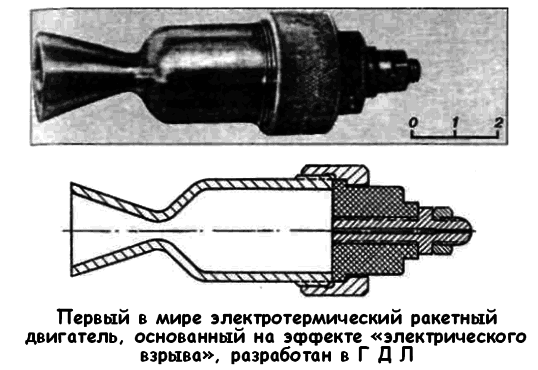
“Soon,” Glushko writes in his book “The Path in Rocket Technology,” it became clear that, for all their prospects, work on electric propulsion prevented events. To go into space, it was necessary to overcome the first stage indicated by KE Tsiolkovsky. Therefore since the beginning of 1930, the focus has been on the development of LRE. "
In less than three years, a whole family of liquid rocket engines (LRE) was created - from ORM-1 to ORM-52. The Moscow group for the study of the jet movement "MosGIRD" was making its first successes. It consisted of S.P. Korolev, F.A. Zander, M.K. Tikhonravov, Yu.A. Pobedonostsev, N.I. Yefremov And soon she was rewarded with an achievement: 17 August 1933, the first Soviet rocket took off. LPD to her developed Zander.
Work on jet engines in the Glushko department of the Leningrad GDL was going well. There is a need to unite two institutions, to concentrate the efforts of young scientists and design engineers in one place. On the initiative of M.N. Tukhachevsky, teams are united in the Jet Research Institute (RNII). The institute was headed by Ivan Terentevich Kleimenov, and S.P. Queen.
In 1934, Glushko reads two courses of lectures at the N.E. Air Force Engineering Academy. Zhukovsky - on rocket engines and fuels for them. The first part of these lectures formed the basis of Glushko’s book Liquid Fuel for Rocket Engines, published in 1936.
While working at RNII, he and his colleagues create an ORM-65 reusable engine for a rocket plane and a projectile aircraft. In the report on the completion of tests ORM-65 S.P. Korolev wrote that testing the launch of the LRE during all the 20 fire tests took place without any malfunctions or failures.
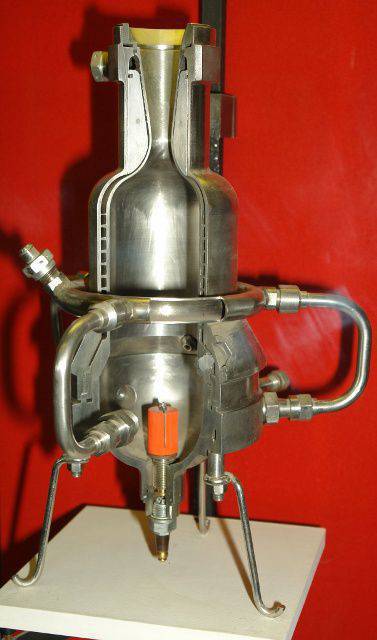
In 1937, I.T. Kleimenov, S.P. Korolev and some other employees RNII. It was not possible to avoid this sad fate and Glushko. He was arrested in March 1938. From Lubyanka, Glushko sends letters to various authorities, and even to Stalin himself, with a request and a request to sort out this tragic mistake. Yes, under moral and physical influence, he first admitted to the charges against him. But in reality, he is not a traitor, not a pest, he has never been a supporter of the “Trotsky-Zinoviev bloc”. “I created two prototype rocket engines and a gas generator for use in marine torpedoes,” he wrote to Stalin. “The material of my charge is only a statement that several laboratory experiments were unsuccessful.” I don’t know how now, but in those years such letters from Lubyanka even reached the head of the country. The investigator was replaced, and at a new interrogation, Glushko refused his first testimony, as if he had prepared an explosion of ORM-65 at one of the tests. Such confessions forced him to make. As a result, he was not released, and was not acquitted then. But then they sent him to a special camp, to a special technical department, which the prisoners themselves called “Sharaga No. XXUMX”.
Fate he still smiled: with the appointment of his chief designer of the OKB-29 NKVD in Kazan, he could do his own thing, develop boosters for Soviet combat aircraft. Indeed, during these years there was a difficult war. With the appointment of Valentin Petrovich chief designer of the NKVD-29 Design Bureau in Kazan, he immediately began to look for the Queen. I wrote to the NKVD a request to send him to the Kleimenov OKB, Langemak and Korolev OKB. Without waiting for an answer, he again appeals to the NKVD. The Queen managed to find in Omsk, in Tupolev "sharashka". With the arrival of Sergei Pavlovich in Kazan, he becomes Glushko’s deputy for flight tests.
Two future outstanding designers and the whole team of OKB engaged in equipping the aircraft with jet engines. Created by Glushko RD-1, it was decided to put on a combat plane - dive bomber Pe-2. During the tests, Valentin Petrovich modified the engine, proposing instead of an electrical ignition system - a chemical one.
RD-1XZZ RD-2 engines were tested on six different types of aircraft - Pe-2, La-7Р and La-120Р, Yak-3, Su-7. Tests of all power plants V.P. Glushko passed successfully. In August, the 1944 of Valentin Petrovich and his staff are released.
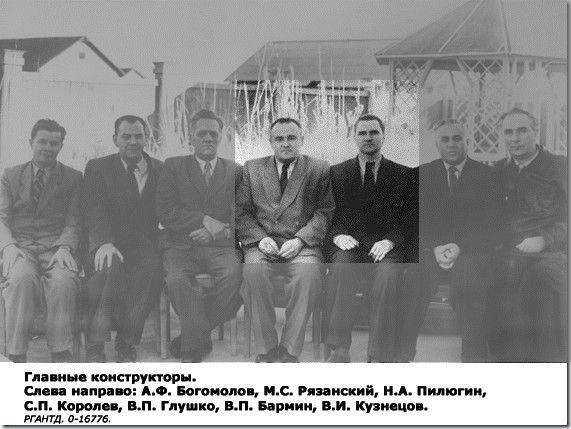
The four-month business trip of Glushko to Germany to the Peenemünde Rocket Center, where Verner von Braun recently created and built Fau-2 rockets, was quite fruitful. Stalin ordered a group of Soviet specialists to familiarize themselves with the documentation, take out what the Americans who occupied Peenemünde. And set the task: copy the German rocket.
Our specialists managed to take out eleven sets of V-2, machine equipment, dismantle the section of the LRE installation. Dozens of German specialists moved to the USSR.
With the return from Germany, Valentin Petrovich wrote a memorandum on the need for the development of rocket science in the country. Report gets to Stalin. For the development of reactive weapons in the country, the resolution of the Central Committee and the Council of Ministers on the development of jet weapons, the organization of a system of research institutes, design bureaus and a testing ground were important in May 1946. A proving ground appeared in Kapustin Yar, where on October 18 X launched a rocket copied from V-1947. She flew 2 km.
But the military needed a much longer missile range. And Valentin Petrovich understood: for a significant increase in the range of the rocket, a new engine is required, much more powerful than the German one for the V-2. And OKB Glushko creates and tests the RD-100 engine. However, the test LRE works tens of seconds, but you need ten to fifteen times longer. In addition, permanent accidents. It took several years to develop a liquid-propellant rocket engine for the R-5M rocket, which provided the launch range of an atomic warhead in 1200 km.
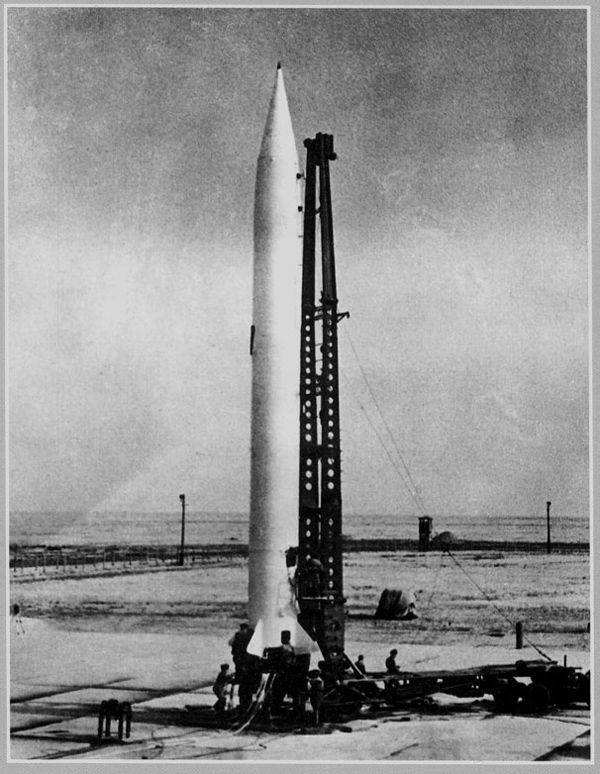
Finally, in August, 1957 in the USSR launched an ultra-long multi-stage ballistic missile with engines that developed in the center of the rocket engine building in Khimki, which was led by Glushko.
With the advent of the powerful P-7 rocket, it was already possible to count on the launch of an artificial Earth satellite (AES), which was intensively being worked on lately. Indeed, in October 1957, the first in the world satellite was successfully launched.
It was the RD-107 engines developed at the Glushko Design Bureau for the first intercontinental rocket R-7 that brought the first satellite, the Luna automatic station, the Vostok, Voskhod and Soyuz spacecraft into Earth orbit. They were the ones who made man’s breakthrough into space.
In the mid-seventies, Glushko became the general designer in the founded S.P. Korolevy Scientific and Production Association "Energy". Here, on the initiative of Glushko, the development of the Vulkan super-heavy launch vehicle began, which became the basis for the future carrier Energia with a payload above 100 t. According to the general designer, it was such a carrier that would allow for the creation of inhabited lunar bases.
For the new rocket developed oxygen-hydrogen engines RD-170. In November 1988, the launch of the reusable space system "Energiya-Buran" with the automatic landing of an orbital spacecraft on the airfield took place.
As Valentin Petrovich recalled, from childhood he dreamed of flying to the moon, about mastering it by man. With the help of powerful engines, which were developed under his leadership, the Moon was investigated by various vehicles. It was the RD-170 that brought the domestic astronautics to the realization of the idea of creating a permanent scientific base on the Moon. And only the death of Glushko, and the collapse of the USSR got in the way of his dream.
Valentin Petrovich died in 1989. Shortly before his death, he bequeathed to dispel his dust above the surface of Venus, where he could deliver a rocket with engines RD-170. However, Glushko’s will was not executed. The great designer and scientist was buried in the Novodevichy cemetery.
After the death of Glushko, by decision of the General Assembly of the International Aerospace Union, in 1994, a crater with a diameter of 43 km located on the visible side of the Moon was named after him. After the first manned flight into space, there were dozens of other flights with crews aboard. The conquest of outer space continues and continues. And one of the pioneers of the rocket business, twice Hero of Socialist Labor, the winner of the Lenin and State Prizes, academician Valentin Petrovich Glushko, made an enormous contribution to his success.
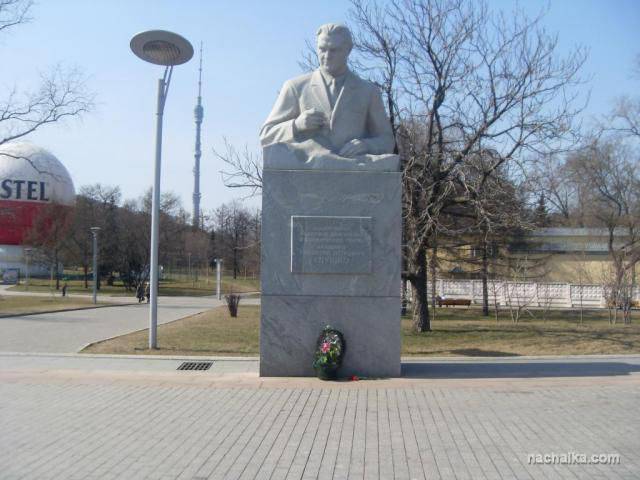
Sources:
Sokolov V. Fire worshipers. M. Polytechnic, 1996. C. 24-44
Dushkin L. So who is who? // Wings of Homeland 1989. No. 7. C. 28-31.
Krikunenko A. The dream of his life. // Wings of the Motherland. 2003. No.4. C. 30-31
Osipchuk I. To the 105 anniversary of the birth of the pioneer of Russian cosmonautics, academician V.P. Glushko // Facts newspaper. 03.09.2013.
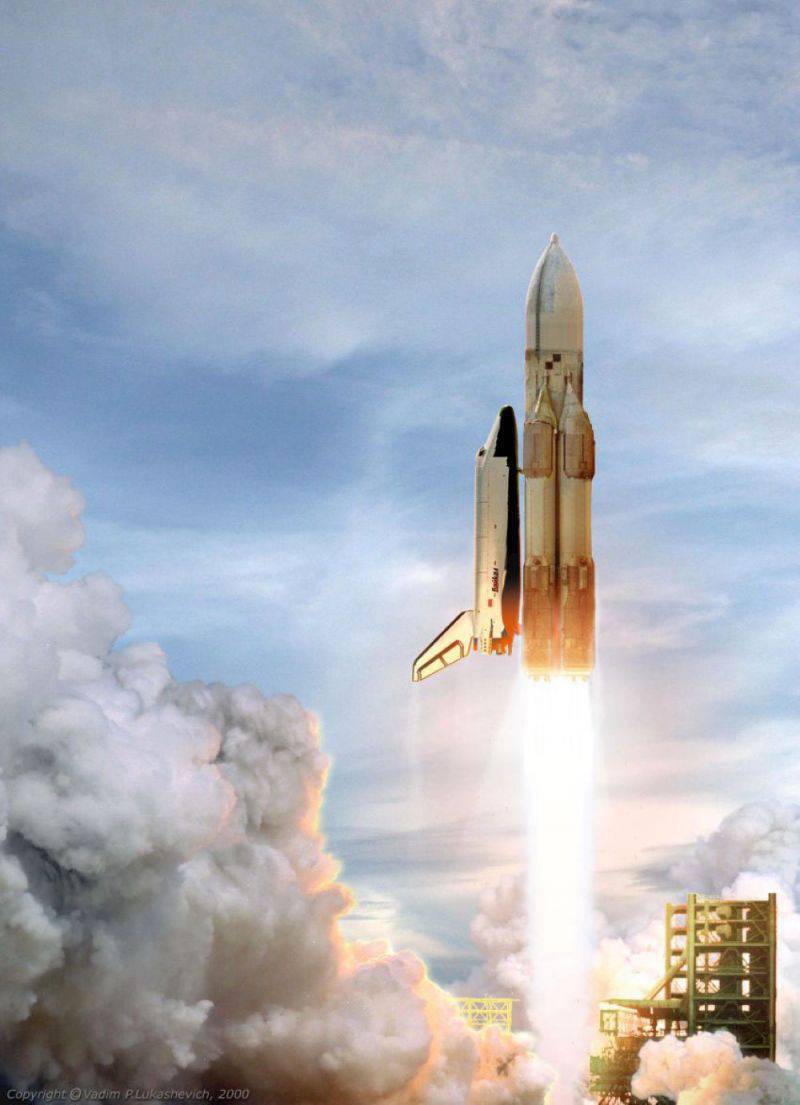
Information